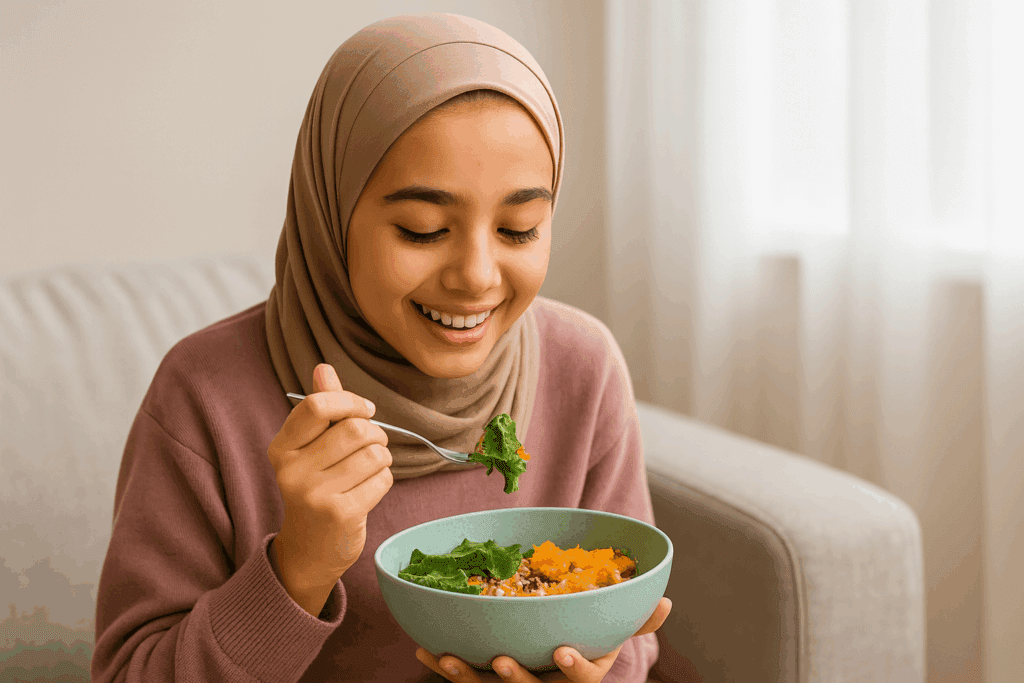
Nourish Your Follicular phase: What to Eat and Why
The follicular phase is a window of repair and renewal. With oestrogen rising and ovulation ahead, the right foods can support you. Below is a simple guide to what to eat (and why), with practical ideas you can use today.
What is the follicular phase?
The follicular phase marks the start of your menstrual cycle. It begins on the first day of menstruation and ends with ovulation. During this phase, your body focuses on repairing the uterine lining and preparing for ovulation. Oestrogen levels rise steadily, influencing energy, mood, and metabolism. Many women notice better focus, lighter mood, and more physical energy, making it an ideal time to align your nutrition with your body’s needs.
Why nutrition matters now
As oestrogen levels rise, your body naturally becomes more efficient at metabolising nutrients, reducing inflammation, and building strength. This makes the follicular phase a prime opportunity to focus on:
- Hormonal balance: Fibre and cruciferous veg (e.g., broccoli) support healthy oestrogen metabolism via the liver and gut.
- Energy production: Whole grains and healthy fats provide sustained energy to match your body’s naturally higher stamina.
- Digestive health: Probiotic (fermented) foods and prebiotic fibre (onion, garlic, lentils) nurture a healthy microbiome.
- Soothe inflammation: Omega-3 fats (e.g., salmon, flaxseed) help modulate cramps and inflammation.
- Iron and vitamin D replenishment: These nutrients, often depleted during menstruation, help combat fatigue and regulate mood.
What to eat during the follicular phase
Fruit and vegetables
Fresh vegetables and fruits are foundational during the follicular phase. Aim for at least 5 portions/day, with half your plate veg at main meals:
- Crucifers: Broccoli, cauliflower, kale, cabbage, rocket — support the liver’s handling of oestrogen.
- Leafy greens: Spinach, chard, watercress — provide iron, folate, magnesium.
- Bright fruit: Berries, citrus, kiwi, apples — rich in vitamin C and antioxidants for repair.
Try: Adding these to salads, smoothies, or stir-fries makes them easy and enjoyable to incorporate into your meals.
Protein
Lean proteins are essential for muscle repair and blood sugar balance. Incorporating foods like:
- Fish & eggs: Oily fish (salmon, mackerel, sardines) 1–2×/week for omega-3s; eggs for B-vitamins and choline.
- Lean meats: Chicken, turkey; or plant proteins: lentils, beans, tofu, tempeh.
Try: Grilled salmon with quinoa and greens; lentil–veg stew with wholegrain bread.
Whole grains
Whole grains like oats, wild rice, and whole wheat provide B vitamins, essential for energy production and reducing fatigue. Their complex carbohydrates support a stable blood sugar level, preventing the energy dips that can follow high-sugar meals.
Try: Oat porridge topped with walnuts and berries; quinoa with roasted veg and tahini.
Healthy fats
Healthy fats are critical for hormonal balance and cellular health. Foods like avocados, walnuts, flaxseeds, and olive oil provide omega-3s and monounsaturated fats, which help reduce inflammation and maintain steady energy levels.
- ALA: Flaxseed, chia, walnuts.
- EPA/DHA: Oily fish (or algae-based supplements if plant-based).
Try: Adding a handful of nuts to your snacks or drizzling olive oil on salads can easily incorporate these healthy fats into your diet.
Sprouted and fermented foods
Sprouted and fermented foods are excellent for digestive health. They contain probiotics that improve gut bacteria, enhancing nutrient absorption and reducing bloating.
- Fermented: Live yoghurt or kefir, sauerkraut, kimchi, miso — for probiotics.
- Prebiotic fibre: Onions, garlic, leeks, oats, legumes, green bananas — feed beneficial bacteria.
Try: Including a serving of fermented vegetables or a glass of kefir in your meals can help support a healthy microbiome.
Simple tips
- Pair foods wisely: Combine iron (lentils, spinach, red meat) with vitamin C (peppers, citrus, berries) to boost absorption.
- Balance your meals: Include a mix of proteins, healthy fats, and complex carbs in every meal to sustain energy levels throughout the day.
- Include protein at every meal: This will help repair tissue, steady blood sugar, and support training.
- Try seed cycling: Pumpkin and flaxseeds are particularly beneficial with supporting oestrogen levels. Add them to smoothies or sprinkle on salads.
- Stay active: The follicular phase is an excellent time for strength training or high-energy workouts. Try 2–3 strength sessions/week, plus brisk walks.
- Be caffeine-smart: Keep to ~1–2 cups/day, before midday. Swap later cups for herbal or decaf to protect sleep and iron absorption.
- Keep hydrated: Water helps with energy production, digestion, and cellular function. Add lemon or cucumber slices for added flavour and nutrients. Add potassium-rich foods (banana, potatoes, leafy greens) if crampy. Season food to taste rather than relying on salty snacks.
Foods to avoid
While focusing on nutrient-rich foods, it’s also wise to limit foods that might interfere with hormonal balance:
- Ultra-processed foods (crisps, instant noodles, processed meats, pastries): Often high in salt and additives, which causes bloating and energy dips.
- Excess caffeine can disrupt sleep and elevate stress hormones, counteracting the calming effects of rising oestrogen.
- Refined sugar may cause blood sugar spikes, followed by energy crashes that impact focus and mood.
Islamic perspective: Nourishing the body and soul
The follicular phase begins with menstruation, a time of renewal and preparation. Eating with intention connects us to Allāh’s provision (rizq) and care.
The Prophet Muḥammad ﷺ modelled moderation and wholesome foods: barley, dates, olive oil, milk, vinegar, honey, and fresh produce — all of which align with a simple, nourishing way of eating. The Sunnah also emphasises mindful eating and gratitude. He ﷺ said: “The son of Ādam fills no vessel worse than his stomach… If he must fill it, then a third for food, a third for drink, and a third for air.” (Sunan Ibn Mājah 3349).
By eating mindfully and nourishing the body with intention, we honour the amānah (trust) Allāh ﷻ has placed with us, avoid isrāf (wastefulness), and practice iḥsān (excellence) in caring for our physical and spiritual health.
Final thoughts
Every woman’s body is unique. Use this phase to listen and adjust. Notice how foods affect your energy, mood, digestion, sleep, and training. If something bloats or drains you, swap it, and note what works. Keep a simple log for a few cycles to spot patterns.
Make it your own! Leafy greens, whole grains, and healthy fats help many, but your portions and picks may differ. Aim for balanced plates, steady hydration, and gentle consistency.
If symptoms are heavy or persistent (e.g., marked fatigue, very heavy bleeding), speak to a trusted clinician for personalised advice. Stay curious and kind to yourself; the goal is a way of eating that truly supports you in the follicular phase.

